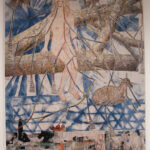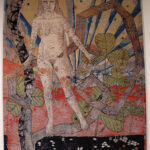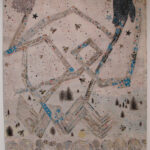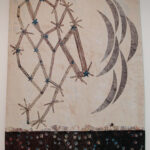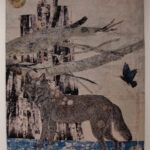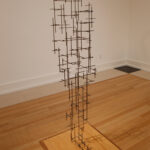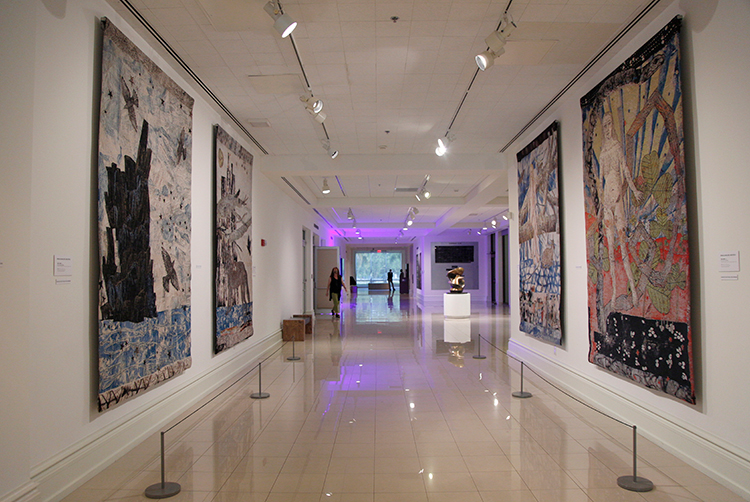
The year’s purchase by the Athena Society, a special membership group of the Vero Beach Museum of Art, has been made.
At the annual Athena Society Dinner last Friday, the vote went to American artist Charles Sheeler’s tempera and ink on paper painting, “Hydro Electric Power, Hoover Dam” of 1950.
The painting was on offer from Meredith Ward Fine Art of New York City, a gallery specializing in 19th century and 20th century American art.
Membership in the Athena Society is $5,000 per year, with monies pooled to purchase artworks for the museum’s collection. The funds have exceeded over $400,000 per annum over the past few years, and usually all or most of those funds are spent on one of the three to five artworks selected for the society’s deliberation by the museum’s director, curator and collections committee from retail galleries “up north.”
The artwork to be purchased is selected by secret ballot and announced at the annual Athena Society Dinner. This year’s dinner was especially happy, because members were once again able to meet following its cancellation last year due to the pandemic.
The Athena Society is an important, but not sole resource for museum acquisitions, thanks to private endowments that fund VBMA art purchases, as well as private donations of art.
Although the society was not able to choose an artwork for the VBMA last year, the permanent collection did grow in 2020 with a John Marin watercolor landscape gifted by Graeme and Claudia Bell, and an oil portrait by Henry Salem Hubbell gifted by Elizabeth Phillips Marshall.
The Athena Society, whose membership currently stands at 88, can afford to give the museum artworks that would otherwise be out of reach for the average small museum. In the VBMA’s fiscal year 2019-2020, membership dues from the society added up to over half a million dollars.
Every year, society members can choose to spend part or all of its funds on an annual art purchase. If, for some reason, funds are left over from an art purchase or if no purchase is made, the remaining money rolls into the following year’s membership income. With no expenditure made last year, the Athena Society had a healthy purchase fund.
The cramp that the pandemic put into everybody’s style also changed the way the artworks for the society’s consideration were displayed this year.
Senior curator Anke Van Wagenberg says that in past years, the art offerings for the Athena Society have been on display to Athena Society members and the public alike, for about a week prior to the society’s dinner. That is because when galleries temporarily loan the artworks to the VBMA, they are, for that duration, off-market to other would-be buyers.
This year, however, the artworks were installed for an additional two weeks before the selection. (By the time this article is published, the unpurchased artworks will have gone back to their lenders.)
Standing in front of six large tapestries designed by American artist Kiki Smith, Van Wagenberg explains that the grouping counted as one choice for this year’s selection. Each tapestry is from an edition of 10 issued by Magnolia Editions, a California-based publisher of multiples on paper as well as tapestry editions. These tapestries came from Krakow Witkin Gallery in Boston.
Van Wagenberg says that while all the artworks under consideration by the Athena Society are generally hung together in the main hall, this year the museum staff decided to hang only the tapestries in the hall. Each is 9.5 feet high and over 6 feet wide. The half-dozen pieces that comprise one selection would have made the other two selections, a human-scale figural sculpture and a 14.5-inch-square painting, appear insignificant by comparison.
“The other two choices are in the Schumann Gallery,” she says.
Concerning Smith’s tapestry set, Van Wagenberg says that people had a lot of questions about how they were made.
She explains that the designs for the tapestries were created by Smith at the same size as the completed tapestries. In the tapestry trade these large-scale, preliminary artworks are called “cartoons.” Smith created them, says Van Wagenberg, as collages on paper composed not only of new art materials, but also of drawings, paintings and prints by Smith that she “repurposed” for her tapestry cartoons.
The cartoons were photographed at Magnolia Editions in Oakland, California, printed to scale, and then sent back to the artist for her further creative work. When Smith decided that her designs were ready to be translated into tapestries, the completed cartoons were sent to a Belgian mill where a specialized electronic, computerized Jacquard machine scanned them and created digital matrixes that directed the machine’s loom to reproduce them as tapestries.
Born in 1954, Smith is the daughter of American sculptor Tony Smith. Her fascination with depicting the human form began in the 1980s, with the deaths of her father of a heart attack at age 67, and eight years later her younger sister, of AIDS. In that decade, Smith began casting human body parts as independent sculptural works. She also began exploring the symbolism of fairy tales, Bible stories and accounts of Catholic saints. She became interested in transmogrification of the body through magical curses or religious ecstasy, as well as by the body’s normal, mammalian functions.
The two most interesting tapestries of the group portray blond, human females in settings that included elements of nature: trees, woodland plants and wild animals. In one of these, a nude woman stands on the lower branch of a tree whose trunk turns into a giant black serpent. The scene recalls Eve, or perhaps Eve’s apocryphal, headstrong predecessor Lilith, whom Smith has also portrayed in a bronze sculpture, versions of which are owned by New York’s Metropolitan Museum of Art and the San Francisco Museum of Modern Art.
Leaving Smith’s work, Van Wagenberg leads the way into the Schumann Gallery to view the other two offerings.
Near the gallery’s entrance is a sculpture made of hundreds of small stainless-steel bars welded together in an openwork, human-shaped configuration. Its there-but-not-quite-there presence in the gallery suggests a Star Trek humanoid being beamed from one place to another.
Titled “Scaffold XVI,” the artwork was created by the 70-year-old British sculptor Antony Gormley. Offered by the Sean Kelly Gallery of New York City, the sculpture is slight, but the artist’s reputation is outsized. The 1994 winner of the Turner prize, Gormley was made a Royal Academician in 2003 and knighted Officer of the British Empire in 2014.
Charles Sheeler’s “Hydro-Electric Power, Hoover Dam” of 1950 is itself a powerhouse of a painting, despite its small size. It is an abstract “landscape” of electrical towers that carry power from the dam, seen in the distant center of the painting, through the rocky terrain on the Arizona side of the mighty structure.
But for the small figure of a workman standing between the huge insulators of a nearby structure, you might be fooled for a second into thinking the painting was a hard-edged abstraction. Its color palette is monochromatic in the limning of the plant and its structures; the sky, however, is painted in three distinct shades of blue: a powdery light ultramarine, a glowing aqua and a rich cobalt. Each color fits neatly into its own precinct, as outlined by the human structures that divvy up that improbable sky.
Born in 1883, Sheeler was both a photographer and a painter. He exhibited six paintings in the 1913 Armory Show in New York City, and made his living taking architectural photos for paying customers.
He also took photos strictly for art’s sake. Sheeler used the medium of photography as an artmaking means in and of itself, as well as inspiration for his paintings. An observation long ascribed to Sheeler goes, “Photography is nature seen from the eyes outward; painting from the eyes inward.”
By 1920, when he showed a collection of his photo prints and paintings at the de Zayas Modern Gallery in New York, he was hailed as the leader of a then brand-new style that came to be known as “Precisionism” for its simplified, crystalline interpretation of cityscapes and industrial buildings.
In 1939, Sheeler was honored by a major retrospective of his paintings, drawings and photographs at the Museum of Modern Art in New York. It was the end of Precisionism’s popularity as an art movement, but not the end of Sheeler’s active art career, as “Hydro Electric Power, Hoover Dam,” demonstrates. Sheeler died 15 years after that painting’s creation, in 1965.
Perhaps his greatest achievement was embracing photography and painting as co-equals in his vision of a modern art for America. The Athenians chose wisely this year.
Photos by Kaila Jones

